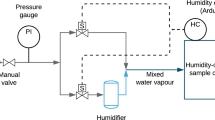This paper presents the results of identifying the transient response of a relative air humidity sensor. It is shown that the capacitive relative humidity sensor is an integrated microprocessor system that performs joint processing of the readings of the absolute humidity sensor and the temperature sensor. A mathematical model of the relative humidity measurement process is proposed. The transient responses of the absolute humidity sensing element and the temperature sensor are specified under the assumption that they correspond to first-order aperiodic factors. Based on the relationships of thermodynamics, Arden Buck equation, and given transient functions, analytical dependencies are obtained to identify the parameters of the transient response of the capacitive relative humidity sensor. The results of several field experiments are processed and analyzed in accordance with the proposed mathematical model. The effect of anomalous sensor readings is revealed and consists in the fact that with simultaneous stepwise changes in humidity and temperature, the sensor records a change in relative humidity with the opposite sign. It has been established that the cause of the anomalous results of relative humidity measurements is the presence of a large difference between the response time constant of the absolute humidity sensing element and that of the temperature sensor. Measures are proposed to prevent anomalous results of relative humidity measurements.


Similar content being viewed by others
References
Y. Feng, A. L. Cabezas, Q. Chen, et al., IEEE Sens. J., 12, No. 9, 2844–2850 (2012), https://doi.org/10.1109/JSEN.2012.2202390.
Singh S. Ravikant, G. Gupta, S. Yadav, et al., Sens. Actuat. A: Physical, 295, No. 15, 133–140 (2019), https://doi.org/10.1016/j.sna.2019.05.023.
W. H. Zhou, L. C. Wang, and L. B. Wang, IEEE Sens. J., 16, No. 15, 5979–5986 (2016), https://doi.org/10.1109/JSEN.2016.2579644.
X. Li, X. Chen, X. Yu, et al., IEEE Sens. J., 18, No. 3, 962–966 (2018), https://doi.org/10.1109/JSEN.2017.2777871.
Y. Feng, L. Xie, Q. Chen, and L. R. Zheng, IEEE Sens. J., 15, No. 6, 3201–3208 (2015), https://doi.org/10.1109/JSEN.2014.2385154.
X. Yu, X. Chen, X. Ding, and X. Zhao, IEEE T. Instrum. Measur., 67, No. 3, 715–721 (2018), https://doi.org/10.1109/ TIM.2017.2784082.
X. Qiu, R. Tang, J. Zhu, et al., Sens. Actuat. B: Chemical, 147, No. 2, 381–384 (2010), https://doi.org/10.1016/j.snb.2010.04.012.
D. Lu, Y. Zheng, A. Penirschke, and R. Jakoby, IEEE Sens. J., 16, No. 1, 13–14 (2016), https://doi.org/10.1109/JSEN.2015.2468082.
B. Korenko, M. Rothhardt, A. Hartung, and H. Bartelt, IEEE Sens. J., 15, No. 10, 5450–5454 (2015), https://doi.org/10.1109/JSEN.2015.2444100.
M. R. K. Soltanian, A. S. Sharbirin, M. M. Ariannejad, et al., IEEE Sens. J., 16, No. 15, 5987–5992 (2016), https://doi.org/10.1109/JSEN.2016.2573961.
J. J. Steele, G. A. Fitzpatrick, and M. J. Brett, IEEE Sens. J., 7, No. 6, 955–956 (2007).
Z. Wenhe, H. Xuan, W. Jianyun, et al., J. Micro/Nanolith., MEMS, MOEMS, 16, No. 3, 1–9 (2017), https://doi.org/10.1117/1.JMM.16.3.034503.
H. P. Hong, K. H. Jung, N. K. Min, et al., IEEE Sens.-Taipei, Taiwan, (2012), https://doi.org/10.1109/ICSENS.2012.6411151.
J. Fraden, Modern Sensor: Handbook [Russian translation], Tekhnosfera, Moscow (2005).
T. Islam, C. Pramanik, and H. Saha, Microelectron. Reliab., 45, No. 7, 697–703 (2005).
A. P. Kir’yanov and S. M. Korshchnov, Thermodynamics and Molecular Physics, Prosveshcheniye, Moscow (1977).
A. L. Buck, J. Appl. Meteorol., 20, No. 12, 1527–1532 (1981).
J. F. Dijksman, Design of Piezo Inkjet Print Heads. From Acoustics to Applications, Wiley-VCH Verlag GmbH & Co. KGaA, Weinheim (2018).
E. V. Kaplya, Izmer. Tekhn., No. 5, 13–18 (2014).
E. A. Alkhimov, A. N. Dovgal, O. B. Ivanova, et al., Izmer. Tekhn., No. 7, 46–48 (2011).
Ch. L. Phillips and R. D. Harbor., Feedback Control System [Russian translation], Lab. Bazov. Znanii, Moscow (2000).
G. Ellis, Control System Design Guide, Elsevier, Waltham (2012), 4th ed.
J. E. Dennis and R. B. Schnabel, Numerical Methods for Unconstrained Optimization and Nonlinear Equations [Russian translation], Mir, Moscow (1988).
Author information
Authors and Affiliations
Corresponding author
Additional information
Translated from Metrologiya, No. 4, pp. 51–68, October–December, 2019.
Rights and permissions
About this article
Cite this article
Kaplya, V.I., Kaplya, E.V. & Silaev, A.A. Identification of the Transient Response of a Capacitive Relative Humidity Sensor. Meas Tech 62, 1099–1105 (2020). https://doi.org/10.1007/s11018-020-01740-0
Received:
Accepted:
Published:
Issue Date:
DOI: https://doi.org/10.1007/s11018-020-01740-0




